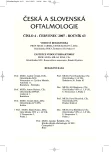Macular Edema after Cataract Surgery in Diabetic Patients without Retinopathy
Makulární edém po operaci katarakty u diabetiků bez diabetické retinopatie
Cíl studie:
Zjistit vliv fakoemulzifikace na rozvoj makulárního edému a diabetické retinopatie u pacientů léčených pro diabetes mellitus bez známek diabetické retinopatie předoperačně.
Pacienti a metodika:
Do studie bylo zařazeno 26 pacientů přicházejících k operaci katarakty a současně léčených pro diabetes mellitus bez známek diabetické retinopatie. Kontrolní skupinu tvořilo 60 pacientů bez diabetu a retinální patologie plánovaných ve stejném období k operaci katarakty. U pacientů ve studovaném souboru byla zjištěna délka trvání diabetu, způsob léčby a předoperačně stanovena hladina glykovaného hemoglobinu v séru (HbA1c). Předoperačně, pooperačně, 1 týden, 1, 2, 3 a 6 měsíců po operaci bylo pomocí OCT provedeno na operovaném oku v obou skupinách měření objemu makuly a tloušťky sítnice ve třech oblastech: foveální, vnitřní a vnější makulární.
Výsledky:
V obou skupinách docházelo pooperačně k nárůstu tloušťky sítnice ve všech sledovaných oblastech s maximem za 1-2 měsíce po operaci a se známkami regrese ztluštění od 3. pooperačního měsíce. Nárůst tloušťky sítnice byl ve skupině diabetiků statisticky významně větší než v kontrolní skupině nediabetiků ve všech sledovaných oblastech i v objemu makuly za 2 měsíce po operaci (Mann- Whitney U test; p < 0,05 pro foveu a vnitřní makulární oblast; p = 0,001 pro vnější makulární oblast a p = 0,005 pro objem makuly), s tendencí k většímu zesílení sítnice také 3. pooperační měsíc. U žádného z diabetiků nedošlo v průběhu sledovacího období k rozvoji diabetické retinopatie a nebyla zde ani nalezena korelace mezi pooperační změnou tloušťky sítnice a hladinou glykovaného hemoglobinu. Výsledná zraková ostrost se v obou souborech statisticky významně nelišila (Chíkvadrát test).
Závěr:
Po nekomplikované operaci katarakty dochází u diabetiků bez známek diabetické retinopatie k indukovaným změnám tloušťky sítnice obdobného charakteru jako u pacientů bez diabetes mellitus, i když u diabetiků byla zaznamenána tendence k výraznějšímu pooperačnímu zesílení retiny.
Klíčová slova:
makulární edém, diabetes mellitus, optická koherentní tomografie, fakoemulzifikace, operace katarakty
Authors:
T. Jurečka; Z. Bátková; J. Ventruba; S. Synek
Authors‘ workplace:
Klinika nemocí očních a optometrie FN u sv. Anny
a LF Masarykovy univerzity, Brno
přednosta doc. MUDr. S. Synek, CSc.
Published in:
Čes. a slov. Oftal., 63, 2007, No. 4, p. 274-284
Overview
Purpose:
To study the effect of phacoemulsification on the development of macular edema and diabetic retinopathy in diabetic patients without preoperative retinopathy.
Patients and methods:
This study comprised 86 patients; 26 diabetics, who had no clinically detectable diabetic retinopathy preoperatively, formed a study group and 60 non-diabetics were included into the control group. Diabetes mellitus duration, preoperative hemoglobin A1c level, and diabetes treatment method were recorded in diabetics. Monocular cataract surgery was performed in all patients. The patients were clinically assessed with OCT examination preoperatively, and postoperatively on day 1, in week 1, and in months 1, 2, 3 and 6 respectively. Foveal, inner macular, outer macular thickness, and macular volume were analyzed.
Results:
The increase of the retinal thickness after the cataract surgery reached maximum in both groups in months 1 and 2. Since month 3 on, there was a progressive decrease in abnormal retinal thickness. There was a significant major increase in retinal thickness in diabetics in all examined areas in month 2 (p<0.05 for fovea and inner macula; p=0.001 for outer macula and p=0.005 for macular volume changes). Trend toward major increase in retinal thickness in diabetics was still evident even three months after the surgery. In no case did a diabetic eye develop clinically detectable diabetic retinopathy during the follow-up period. The correlation between hemoglobin A1c level and retinal thickness changes in diabetics was not significant. There was also no significant difference in final visual acuity between diabetics and non-diabetics.
Conclusion:
We can expect similar induced retinal thickness changes in diabetics without retinopathy as in non-diabetics after uneventful cataract surgery, though there was a trend toward major increase in retinal thickness in diabetics.
Key words:
cystoid macular edema, diabetes mellitus, optical coherent tomography, cataract surgery, phacoemulsification
Labels
OphthalmologyArticle was published in
Czech and Slovak Ophthalmology

2007 Issue 4
Most read in this issue
- Macular Edema after an Uncomplicated Cataract Surgery
- Clinical Results of the Aphakia Correction by Means of Secondary Implantation of the Iris-Fixated Anterior Chamber Intraocular Lens
- Analysis of Movement Disorders Surgeries at the Department of Ophthalmology, the FNKV Hospital, Prague, Czech Republic, during the Ten-Years Period
- Evaluation of Glaucoma Progression by Means of HRT II Results
